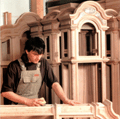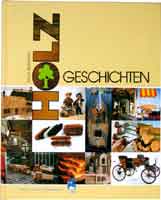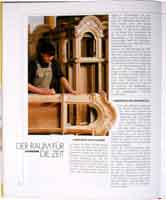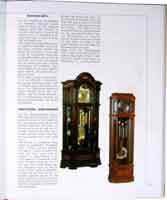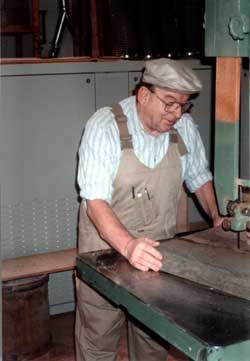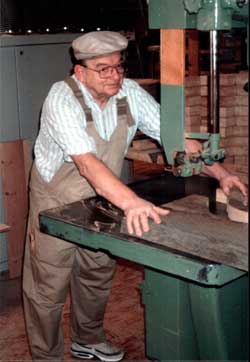
|
| ||||||||||||||||||||||||||||||||||||||||||
| ||||||||||||||||||||||||||||||||||||||||||
|
History
of the
SCHNEIDER-GEHÄUSE cabinet-making company (by Werner Schneider) |
||||||
|
After
he left school my grandfather worked in the cabinet-making department
of the Kienzle clock factory in Schwenningen, where his father
(Josef) was also employed on the production of clock cabinets.
After a few years my grandfather had the idea of becoming independent,
and so he gave up his job and began an apprenticeship at the
firm of Karl Müller (cabinet-making and floor coverings)
in Uhlandstraße in Schwenningen. After he passed his apprenticeship
he worked for several more years as a cabinet maker for various
companies.
In 1928, during the economic crisis, he took his master craftsman's exam and founded a cabinet-maker's that also laid floor coverings (e.g. lino and stragula). For this purpose he had an 8.5 metre x 6 metre building built. To begin with he was active in interior finishing and furniture construction. As my grandfather was the only person offering floor coverings in Deißlingen, a large part of the business in this area was directed towards the company. Because of the skills he had acquired at Kienzle, he soon began constructing clock cabinets. He sold these to the clock factories in the nearby clock-making town of Schwenningen. |
||||||
|
1928
Founding of the company
|
||||||
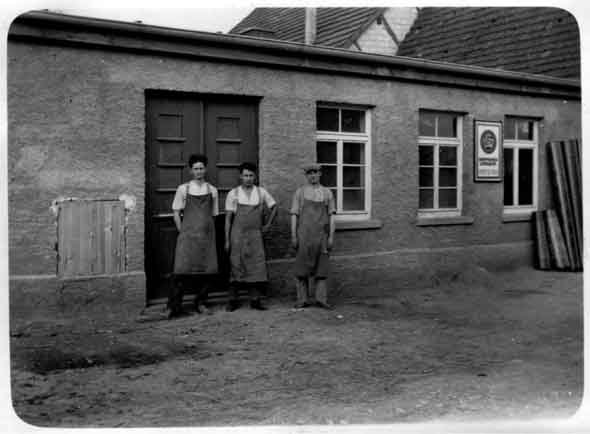 |
||||||
|
Foundation
picture:
On the right of the picture is founder August Schneider; to his left two colleagues. The filled-in hole in the house wall had been opened up to allow long pieces of wood to be planed. On the wall to the right freshly-delivered floor coverings can be seen. |
||||||
|
August
Schneider Cabinet-makers and Linoleum
|
||||||
|
The company was unusual in Deißlingen, because my grandfather was active both as a joiner and as a floor-layer. In his capacity as joiner he built furniture, decorative boxes and clock cabinets, and in addition he was active in interior finishing. As a floor-layer he laid floors, for example out of lino, stragula or embossed lino. He delivered the clock casings, which he was able to construct as a result of his skills acquired at Kienzle, to the clock factories in Schwenningen. At that time the casings were still transported by handcart to the local varnish works. Because of the small amount of money that was available at the time of the economic crisis, there were not many means of investing in the company. In the cabinet shop a then-normal transmission (1 motor for 4 machines) was installed. Slowly the business became stronger, and a varnish workshop was put in outside the main factory building (a rented building, approximately 300 metres from the cabinet works). Three female employees were employed at this task, and in this way varnishing was brought into the production process. Meanwhile the business gradually became busier, and so five extra employees were taken on. At the outbreak of war in 1939 five employees in addition to the proprietor were employed in the cabinet works, and three more in the varnishing department. The purchse of a Volkswagen Beetle was even being considered, but this was prevented by the outbreak of war. |
||||||
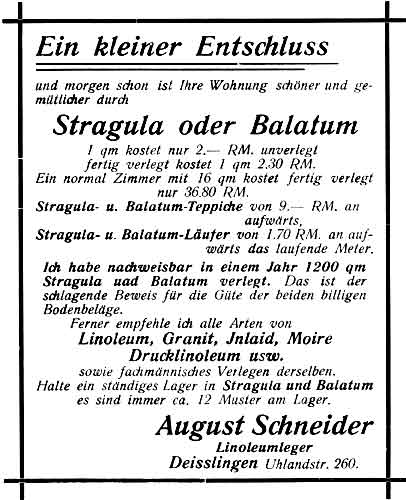 |
||||||
|
Press
advertisement from 1930
Journal from Deißlingen Trade bank 1870 - 1930 |
||||||
|
1939
|
||||||
|
At
the beginning of the Second World War the employees and my grandfather
were called up for military service. As a result the business
was suspended until the end of the war. My grandfather was on
the Eastern Front until 1944. In the winter of 1944/45 he was
sent to the Western Front, where he was taken prisoner by the
Americans. From there he returned in autumn 1945.
|
||||||
|
1945
Painful rebirth
|
||||||
|
Shortly
after the Second World War it was very difficult to acquire
raw materials, but after August Schneider had succeeded at that
he was able to make a fresh start and rebuild the business.
At this time almost all businesses were run on a barter basis,
because the Reichsmark was very weak. So for instance my grandfather
exchanged 5 clock cabinets for one complete clock, which he
could then exchange for raw materials or food.
|
||||||
|
1948
Monetary reform
|
||||||
|
The
economy in West Germany stabilised itself via the "Deutschmark"
and the upturn began. Even in Deißlingen business was
good once again, there was a lot of demand in the clock-making
industry and August Schneider could even export his clock cabinets.
Because of the increase in production rationalization became
necessary, and so a new building was planned.
|
||||||
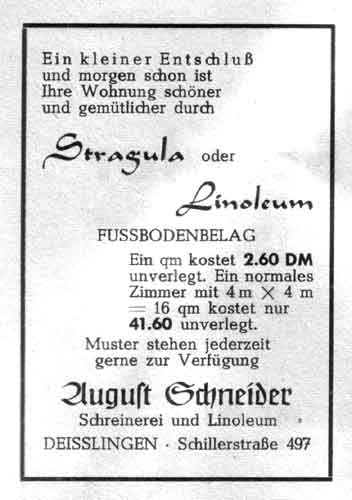 |
||||||
|
Advertisement:
Celebration leaflet from 1950:
75 years of the Deißingen singing circle |
||||||
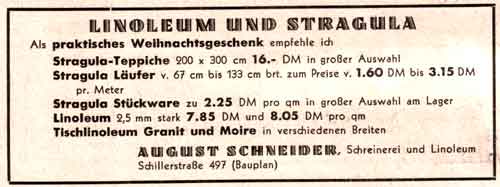 |
||||||
|
Advertisement
from the Deißlinger Amtsblatt, Friday 11th Dezember 1953
|
||||||
|
1959
New premises
|
||||||
|
The
new business premises, with living accommodation above the workshops,
were built next to the old ones. The shop floor area was now
twice as big as before (approx. 100 m²). The old workshop
continued to be used as a store room and sales area for floor
coverings. As a result of offering new models demand constantly
rose, with the result that the prodcution area quickly became
too small.
|
||||||
|
1965
Extension
|
||||||
|
to
the existing building, with cellar facilities. This extension
brought an additional production space of approx. 40 m².
Central heating was installed in the cellar, which at the time
was a great step forward. Until then a glue heater with sawdust
furnace had been in use. Because of a further increase in production
a second extension soon became necessary.
|
||||||
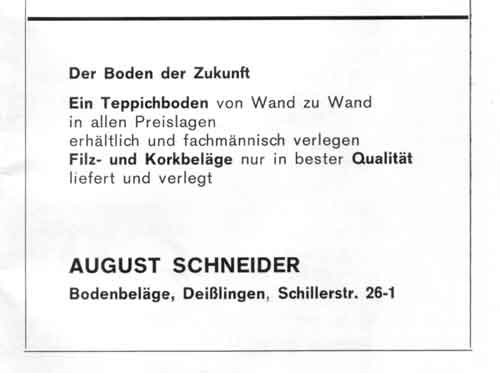 |
||||||
|
1967
Press advertisement in the publication celebrating 75 years
of brass band music in Deißlingen
|
||||||
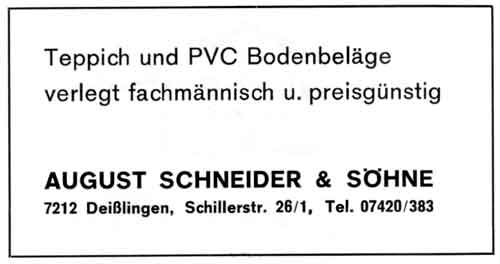 |
||||||
|
1970
Press advertisement in the publication celebrating 100 years
of the Deißlingen voluntary fire brigade
|
||||||
|
1972
|
||||||
|
The
second extension, also with a cellar, brought an additional
surface area of 40 m². The cellar was used as an office
and heated storage space.
In the same year the sons of August Schneider, Manfred (my father) and Libert, were made partners in the business. The Firm of August Schneider & Sons OHG was entered into the business register. |
||||||
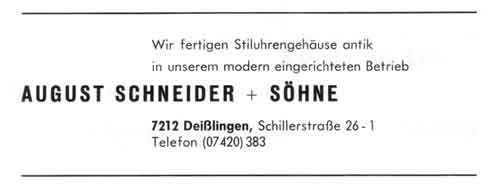 |
||||||
|
1973
Press advertisement in the information leaflet for the International
Cycling Meeting in Deißlingen
|
||||||
|
1978
|
||||||
|
The
business celebrated its 50th anniversary
|
||||||
|
1980
|
||||||
|
Until
around 1980 table-, wall- and grandfather clock casings were
produced. Because of the fall in the value of the dollar exports
dropped by around 80% and a reduced working week had to be introduced
for approximately 2 years.
|
||||||
|
1983
|
||||||
|
Production
concentrates on grandfather clock casings. By bringing out new
models of grandfather clocks Manfred Schneider was able to increase
demand and reintroduce full-time working.
|
||||||
|
1987
|
||||||
|
The
factory building once again became too small as a result of
constantly increasing demand. As a result Manfred Schneider
began a new factory building in the Breite Industrial Estate
in Deißlingen.
|
||||||
|
Werner
Schneider, the son of Manfred Schneider, passed his joiner's
exams as Guild Champion after a three-year apprenticeship with
the joinery Lutzeier in Rottweil.
|
||||||
|
1988
|
||||||
|
January
1988 Manfred's son Werner has been working with his father's
business.
|
||||||
|
The new factory building was completed and equipped in April. (approx. 26 x 26 metres, or 676 m² and wood storage of approx. 100m² ) and brothers Manfred and Libert went their separate ways. Besides the proprietor Manfred, 4 other employees were with the company. The grandfather clock palette was permanently extended by Manfred Schneider. |
||||||
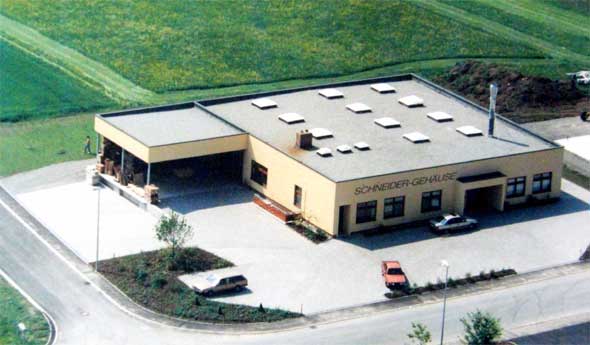 |
||||||
|
1989
The new company are in the newspaper "Schwarzwälder
Boten"
|
||||||
|
(click
on the picture for Download)
|
||||||
|
1990
|
||||||
|
The
Model 8790 was introduced. Up to now this is the largest grandfather
clock in the Schneider-Gehäuse range.
|
||||||
|
1992
|
||||||
|
Werner
Schneider attends Technical School in Stuttgart and begins the
training course as an officially qualified wood worker. At this
time Werner Schneider also takes his Master Craftsman's Exam,
'Refa' exam and qualifies as a safety expert.
|
||||||
|
1994
|
||||||
|
Werner
Schneider returns to the family business after successfully
completing the training course.
|
||||||
|
The
SCHNEIDER-GEHÄUSE company is featured in the book "HOLZ
Geschichten" by Erich Hermann (Moritz Schauenburg Verlag,
ISBN3-7946-0312-2)
|
||||||
|
(for
Download click on the pictures)
|
||||||
|
1996
|
||||||
|
Manfred
Schneider develops a system of clock face illumination (patented),
the first of its kind.
|
||||||
| 1996 Report for the "German Street of clocks" monday, 12th August 1996 | ||||||
|
(click
on the picture for Download)
|
||||||
|
1998
|
||||||
|
The
SCHNEIDER-GEHÄUSE company celebrates its 70th anniversary
and Werner Schneider takes over the company. This means that
the fourth generation of Schneiders is now fashioning clock
casings from wood. After 49 years Manfred Schneider, hitherto
the proprietor, begins his retirement.
In addition to table-, mantelpiece- and wall clock cabinets, production concentrates mainly on grandfather clock cabinets. All cabinets without exception are designed by us and are patented. A new product is the Model 70 "Jubilee" with the Schneider designed and patented clock face. |
||||||
|
||||||
|
April
1998, Manfred Schneider cutting out the clock top bows on a
band saw
|
||||||
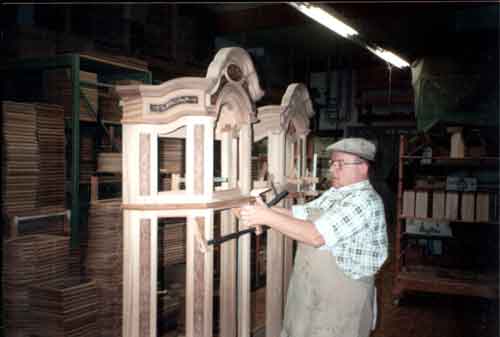 |
||||||
|
April
1998, Manfred Schneider gluing clock casings
|
||||||
|
2000
|
||||||
|
The
range of casings is extended by wall clocks and a wall display
case. A goods forwarding building is built next to the production
building, for packing and sending the products. From this time
individual clocks can be sent worldwide via airmail and larger
shipments can be sent by sea.
|
||||||
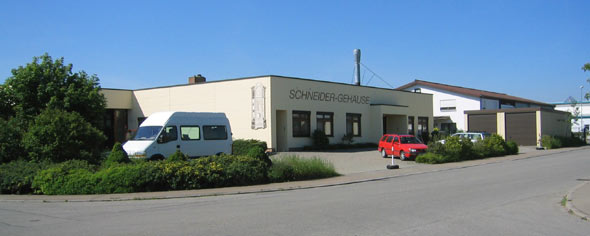 |
||||||
|
2001
|
||||||
|
The
varnish workshop is refurbished and the cabinets are now varnished
and assembled by us.
|
||||||
|
2002
|
||||||
|
The
clock face lighting is refined and can now be delivered with
neon light and in 110 or 220 volts. The clock exhibition, as
part of the celebrations for Deißlingen's 1200th anniversary,
is supported by the company.
|
||||||
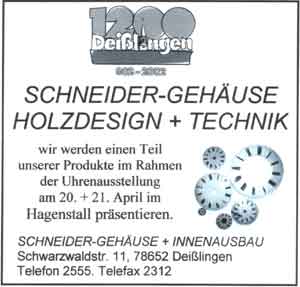 |
||||||
|
2002
im April, advertisement in the Deißlinger Amstblatt
|
||||||
|
2003
|
||||||
|
company
celebrates its 75th anniversary.
|
||||||
|
2004
|
||||||
|
The
SCHNEIDER-GEHÄUSE company introduces itself with a homepage
on the "World Wide WEB".
|
||||||
